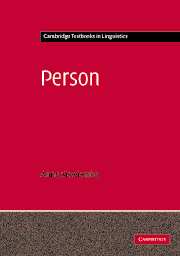Book contents
- Frontmatter
- Contents
- List of figures
- List of tables
- Preface
- List of abbreviations
- 1 Introduction
- 2 The typology of person forms
- 3 The structure of person paradigms
- 4 Person agreement
- 5 The function of person forms
- 6 Person forms and social deixis
- 7 Person forms in a diachronic perspective
- Appendix 1 List of languages in the sample by macro-area
- Appendix 2 Genetic classification of languages cited in the text
- References
- Author index
- Language index
- Subject index
Preface
Published online by Cambridge University Press: 05 June 2012
- Frontmatter
- Contents
- List of figures
- List of tables
- Preface
- List of abbreviations
- 1 Introduction
- 2 The typology of person forms
- 3 The structure of person paradigms
- 4 Person agreement
- 5 The function of person forms
- 6 Person forms and social deixis
- 7 Person forms in a diachronic perspective
- Appendix 1 List of languages in the sample by macro-area
- Appendix 2 Genetic classification of languages cited in the text
- References
- Author index
- Language index
- Subject index
Summary
This book has two major aims. First of all, it seeks to provide an overview of the various manifestations of the category person in the grammatical system of the world's languages. And secondly it offers a potential account of the principles determining the distribution and form of person markers in utterances. The approach adopted is functional-typological and thus the stress is on the underlying cognitive and discourse basis of person systems and their exponents, on the one hand, and on how these factors are reflected in the existing patterns of cross-linguistic variation, on the other.
While the grammatical category of person is typically associated primarily with that of free personal pronoun, in this book no pride of place is assigned to free as opposed to bound forms or pronouns as compared to agreement markers. A major thread running throughout the discussion is that these different instantiations of the category of person are best viewed as defining both a diachronic and a synchronic cline in regard to their formal and functional properties. Accordingly, no attempt is made to establish universally applicable unique cut-off points on the cline but only to determine the recurring convergences of properties that tend to be found cross-linguistically.
- Type
- Chapter
- Information
- Person , pp. xv - xviPublisher: Cambridge University PressPrint publication year: 2004



